The following are the most important historical and current Artificial Intelligence statistics for those researching the markets or industry.
Key Statistics
- The global market for Artificial Intelligence is expected to grow from 58.3 billion in 2021 to 309.6 billion by 2026, at a CAGR of 39.7%.1
- $15.7 trillion is the anticipated contribution of Artificial Intelligence to the global economy by 2030.3
- China’s GDP growth is likely to see a boost of 26% because of the adoption of Artificial Intelligence.2
- $6 billion or more is the likely investment of the US government for AI-related projects in 2021.72
- Companies leveraging Artificial Intelligence in the next five to seven years will increase their cash flow by more than 120% by 2030.12
- 30% of the global human workforce is likely to be replaced by Intelligent robots by 2030.16
- Artificial Intelligence could bring in 8.9 million new cognitive jobs in the US by 2025.20
- Artificial Intelligence can create 97 million global jobs in 2025.19
- 84% of businesses think AI will help them to gain or maintain a competitive advantage.28
- 40% of business owners feel that high technology costs and the lack of expertise are limitations for AI adoption.32
- ChatGPT, the popular chatbot from OpenAI, is estimated to have reached 100 million monthly active users in January, just two months after launch.80
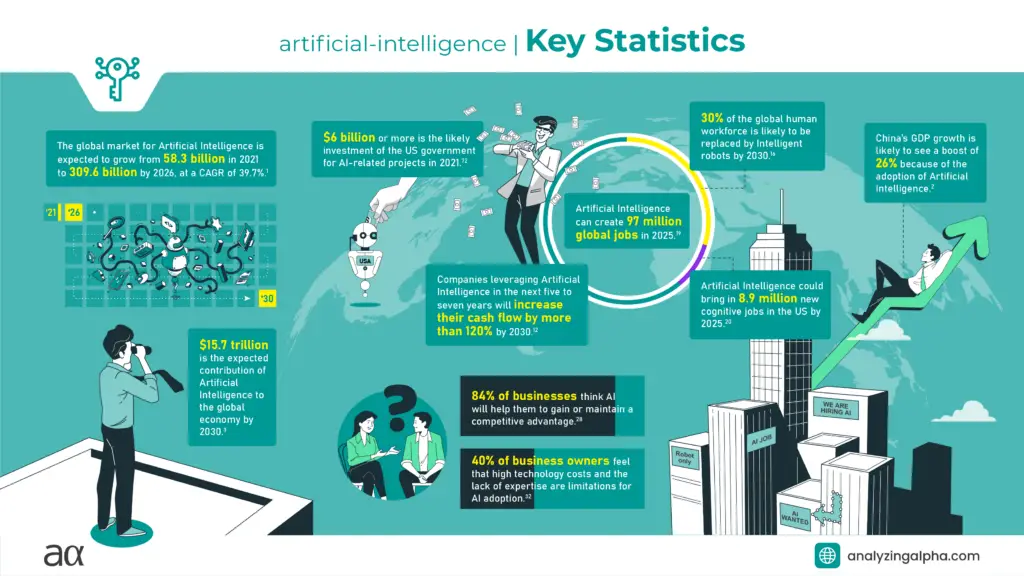
Artificial intelligence plays a crucial role in optimizing and transforming businesses worldwide. This disruptive technology has recently gained a lot of traction and is changing the entire business landscape.
There are many nuances in integrating AI into business operations because enterprises may find it risky to implement. However, considering the progress made by AI in every walk of life, it has become imperative for businesses to loop AI into their internal processes.
In this article, I have compiled critical historical and latest artificial intelligence statistics that will help you gauge the industry trends.
Artificial Intelligence Market Statistics
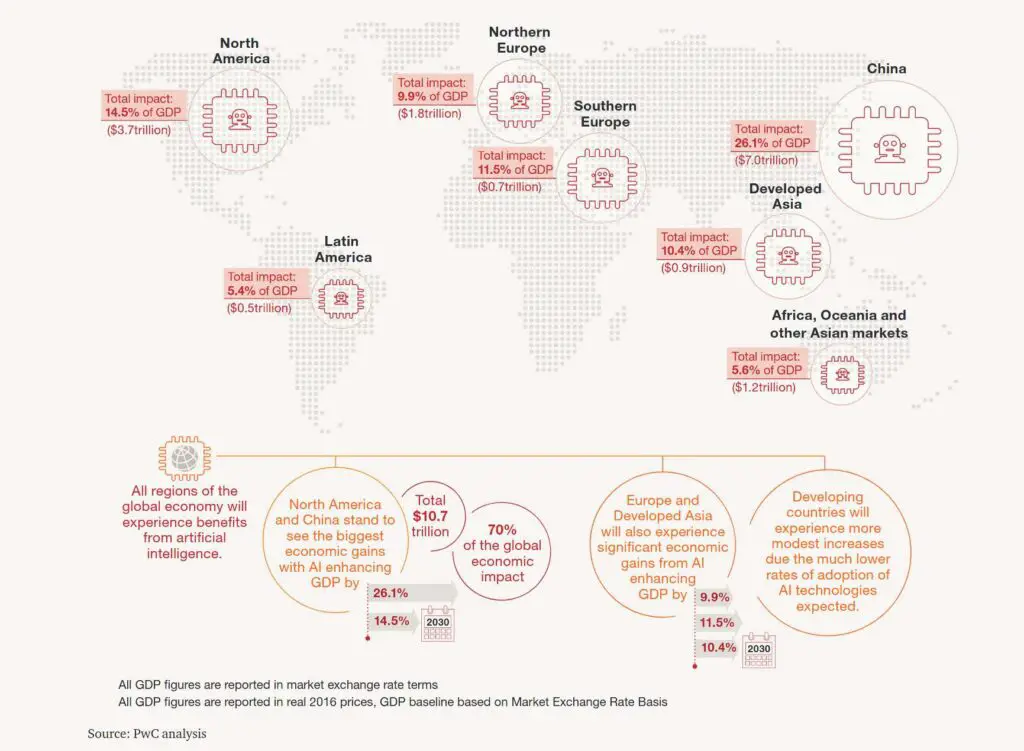
- The global AI market is expected to grow from 58.3 billion in 2021 to 309.6 billion by 2026, at a CAGR of 39.7%.1
- With a 26% boost to GDP in 2030, China will see the most significant economic gains from AI.2
- North America’s GDP is likely to get a 14.5% boost in GDP from AI.2
- North Europe’s GDP is expected to get a 9.9% boost in GDP from AI.2
- South Europe’s GDP is likely to get an 11.5% boost in GDP from AI.2
- Latin America’s GDP is expected to get a 5.4% boost in GDP from AI.2
- Developed Asia and ROW to see a 10.4% and 5.6% growth in GDP from AI, respectively.2
- $15.7 trillion is the potential contribution of
- AI to the global economy by 2030.3
- Global AI hardware market revenue is expected to grow to $234.6 billion in 2025.4
- The global AI software market will grow to $22.6 billion.5
- Global expenditure on cognitive and AI systems would expand to $ 57.6 billion in 2021, according to research firm IDC.6
- 75% of commercial enterprise applications will use AI by 2021 predicted by IDC.7
- The global AI chip market revenue is expected to reach $93 billion by 2027.8
- The US economy would have a potential annual savings of $150 billion through AI in clinical medicine by 2026.9
- By 2024, 50% of AI investments would be quantified and linked to specific KPIs to measure RoI.10
- The Wearable AI Market size is predicted to reach $180 billion by 2025.11
- Companies that use AI in the next five to seven years will increase their cash flow by more than 120% by 2030.12
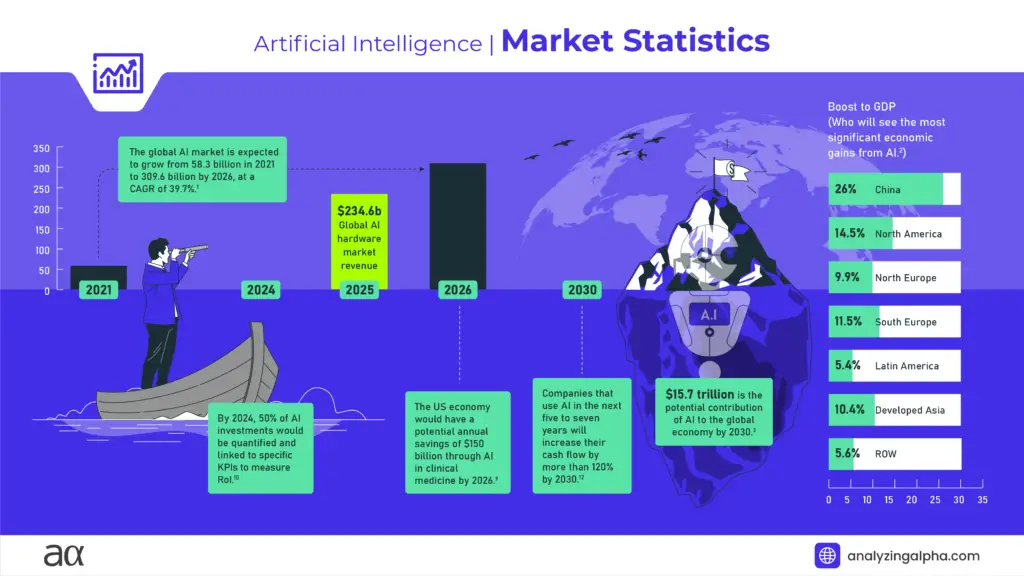
Artificial Intelligence and Covid-19
COVID-19 has wreaked havoc across the globe over the past year. However, there have been unprecedented efforts to tackle the pandemic, and Artificial Intelligence has played a pivotal role.
AI has been leveraged to identify disease clusters, contact tracing, predict outbreaks, monitor cases, and diagnose. Even corporations have adopted AI to minimize the impact of the pandemic. Below are a few artificial intelligence statistics that illustrate its application in the management of COVID-19.
- During COVID-19, 61% of high-performing companies have boosted their AI and Machine Learning investment.13
- 32% of the marketing and sales AI models adopted since the pandemic have underperformed.13
- 21% of the product and service development AI models adopted since the pandemic have underperformed.13
- 19% of the service operations AI models adopted since the pandemic has underperformed.13
- 16% of European companies feel that automation with AI and other technologies could minimize the adverse impact of COVID-19.14
- Japan plans to create 10 AI-based hospitals by 2022 to address the lack of medical personnel and mounting expenses.15
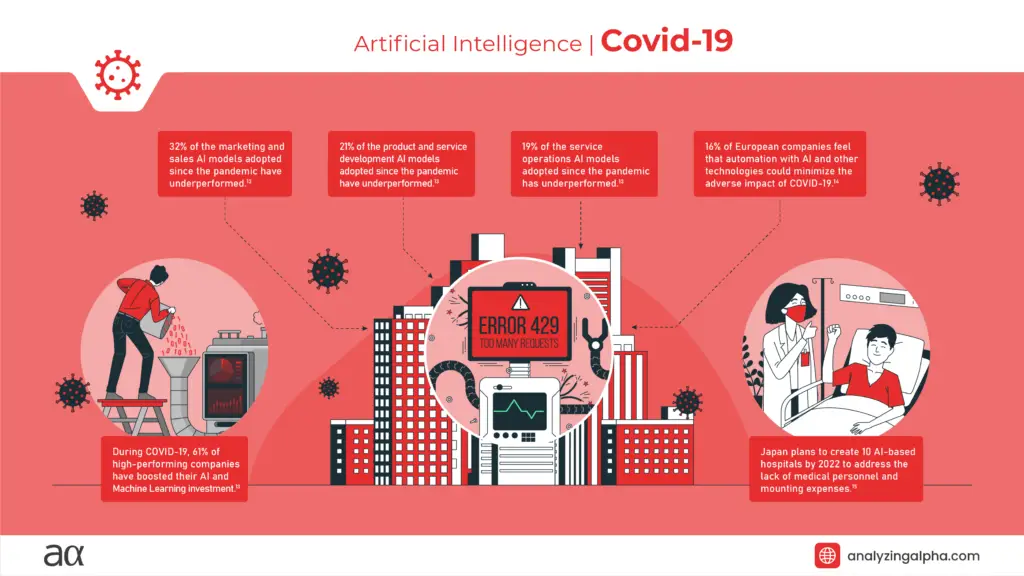
Artificial Intelligence and Employment
In this technology-driven world, automation is a reality. Due to the immense capability of automation, it is the future. On the one hand, it will displace many jobs, while on the other hand, it will create new cognitive jobs.
The below statistics mention how the employment landscape will change amid the rise of Artificial Intelligence.
- Intelligent robots could replace 30% of the global human workforce by 2030.16
- There are 2.25 million robots in use across the world. The number has increased three-fold over the past two decades.17
- 52% of experts believe that automation will innovate more jobs by 2025.18
- AI can create 97 million global jobs in 2025.19
- AI can displace 85 million international jobs in 2025.19
- 50% of global employees will require reskilling by 2030.19
- 16% of US jobs may be replaced by technologies like machine learning, AI, robots, and automation by 2025.20
- 7% of US jobs would be replaced by robots, artificial intelligence (AI), machine learning, and automation by 2025.20
- 36 million Americans with high exposure to automation jobs can have 70% of their tasks done by robots by 2030.21
- Robots and automation could eradicate 20 million manufacturing jobs globally by 2030.17
- 14 million robots will be put to work in China by 2030.17
- 61% of enterprise decision-makers believe that their organizations will employ a Chief AI Officer (CAIO).22
- Forrester forecasts 8.9 million new cognitive jobs in the US by 2025, including robot monitoring professionals, data scientists, automation specialists, and content curators.20

Artificial Intelligence Advantages
- AI-friendly businesses could gain market up to $1.2 trillion annually from companies that are yet to incorporate AI.23
- The number of companies adopting AI expanded by 270% in four years. Maximum growth was seen between 2018 and 2019.24
- Profits of companies with AI are expected to increase by 38%, generating over $14 trillion of additional profit by 2035.25
- By 2020, companies expected AI to contribute a 39% average revenue increase and a 37% reduction in operating costs.26
- 85% of the executives believe incorporating AI will gain an edge in their respective industries.27
- 84% of businesses think AI will help them achieve or maintain a competitive advantage.28
- 75% of enterprises believe AI will empower them to explore new companies.28
- 80% of business and technology leaders feel AI improves productivity and creates jobs.29
- 72% of business leaders believe AI enables people to focus on meaningful work.30
- Companies that leverage AI in the next five to seven years would boost their cash flow by over 120% by 2030.31
- 51% of CEOs revealed that their primary AI goal is to enhance their products’ features, functions, and performance.32
- 36% of CEOs stated that the primary AI goal is to optimize internal business operations.32
- 36% of CEOs stated that their primary AI goal is to put workers to more creative functions by automating tasks.32
- 79% of the global business leaders say AI would make their jobs easier and efficient.33
- 59% of CEOs believe that their company’s big data can be improved through AI.34
- 72% of decision-makers say AI will be the business advantage of the future.35
- 63% of global consumers believe that AI will be instrumental in resolving complex problems in modern society.35
- 59% of executives say AI can enhance the use of big data in their organizations.36
- 14% of the average click-through rates leverage AI for personalizing and segmenting customer communications.37
- The number of AI startups since 2000 increased 14 times by 2018.38
- 75% of executives expressed concerns over going out of business in 5 years if they fail to scale AI.39
- 37% of organizations in 2019 used AI for their operations.40

Artificial Intelligence Adoption Limitations
- According to 47% of CEOs, difficulty in integrating cognitive projects with existing processes is a hurdle in AI adoption.32
- 40% of CEOs feel that high technology costs and the lack of expertise are limitations for AI adoption.32
- 37% of executives think that inability to understand cognitive technology and its working is a barrier to AI adoption.32
- 93% of automation technologists feel they aren’t fully prepared to handle the challenges posed by intelligent machine technology.20
- 77% of CEOs say AI and automation would increase vulnerability and disrupt business practices.41
- 76% of CEOs are worried about the bias potential and lack of transparency related to AI adoption.41
- By 2022, 85% of AI projects will produce inaccurate results due to anomalies in the data, algorithms, or groups handling them.42
- 16% of top leaders aren’t willing to migrate to cloud-based services.43
- 15% of large organizations and 14% of SMBs are reluctant to shift to a cloud-based platform.43
- 4% of businesses avoid adopting AI technology due to legal implications, risks, or compliance issues.44
- 47% of SMBs and large organizations feel that the lack of budget is a critical obstacle in adopting AI.43
- More than one-sixth of respondents blamed lack of skills as a deterrent from companies from adopting AI.44
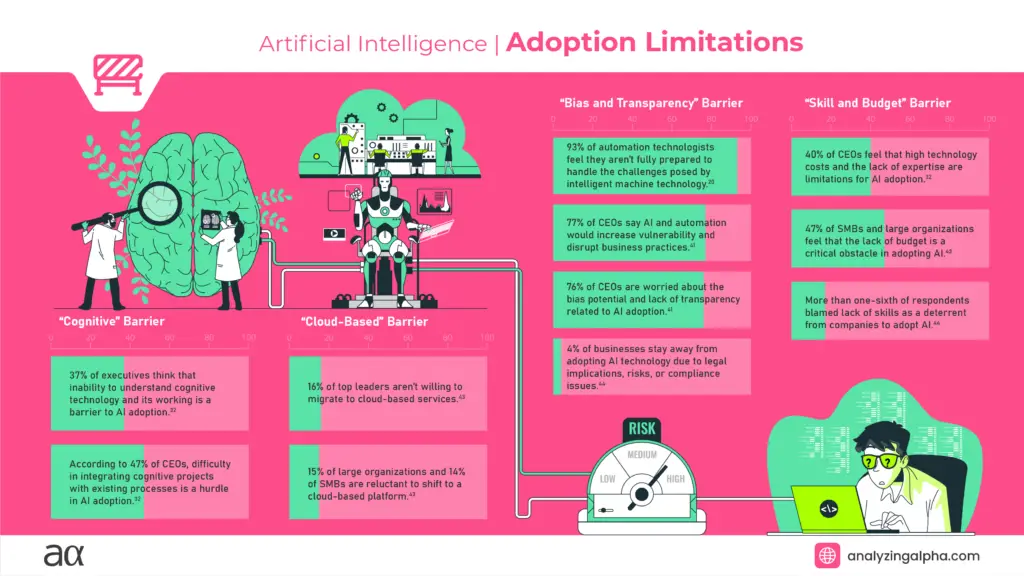
AI Industry & Sector Statistics
- 40% of Marketing and Sales teams state that AI and machine learning are essential for their success.79
- 70% of R&D departments are likely to adopt data science, AI, and machine learning, leading all functions in an enterprise.45
- 27% of financial services and insurance, 25% of healthcare, and 24% of retail and wholesale enterprises say data science, AI, and machine learning are critical to their success.45
- Less than 10% of Educational institutions consider AI and machine learning vital to their success.45
- 72% of tech, media, and telecommunications companies expect AI to significantly impact product offerings over the next five years.28
- 29% of AI automation is required for machine and asset maintenance in manufacturing.46
- There was a 20% reduction in forecast errors due to AI implementation in consumer packaged goods.46
- 10% of nursing activities can be freed up due to automation by 2030. 47
- The AI healthcare market is expected to reach $6.6 billion by 2021.48

Artificial Intelligence in Retail
- 73% of retailers plan to adopt AI by 2021 to optimize their pricing.58
- 85% of retailers plan to adopt AI by 2021 for supply chain planning.58
- Amazon reduced its “click to ship” time to 15 minutes through Machine Learning, indicating a 225% decrease.59
- Global spending on AI in the retail sector will grow to $7.3 billion per year by 2022.60
- According to the Association of Certified Fraud Examiners (ACFE), 13% of organizations use artificial intelligence (AI) and machine learning to detect and prevent fraud in retail transactions.61
- 25% plan to adopt AI for fraud detection in retail in the next two years, signaling a 200% increase.61

Artificial Intelligence in Customer Service
- 27% of consumers around the world say AI can deliver better customer service than human agents.62
- 73% of global consumers are open to the adoption of AI by businesses.62
- 38% of consumers say AI will boost customer service.62 15% of the worldwide customer service interactions will be powered entirely by AI by 202163
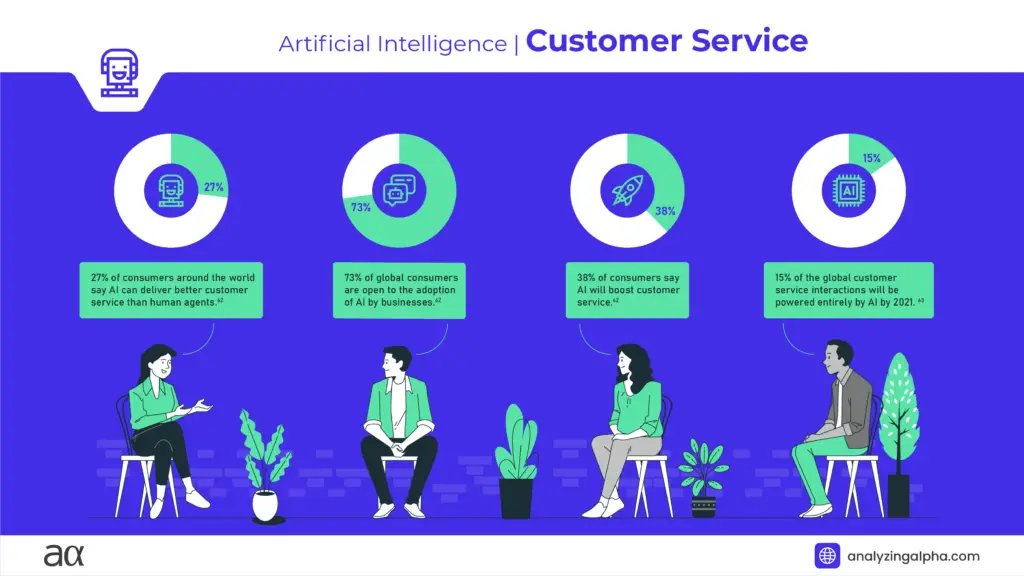
Artificial Intelligence and Sales
- 79% of organizations believe that AI adoption in marketing and sales has helped boost business revenue.64
- Companies have earned a minimum of 20% Earnings Before Interest and Taxes or EBIT due to AI-based strategies.64
- 54% of sales leaders expected to adopt Artificial Intelligence by 2020.65
- 21% of sales leaders stated that their organizations use AI in 2018.65
- 30% of all B2B companies would use A by 2020 to improve at least one of their core sales processes.66
- Companies using AI for sales have seen over a 50% increase in leads, 60-70% reduction in call times, and a 40-60%.67

Artificial Intelligence and Marketing
- 40% of SMBs are yet to invest in any emerging technology to boost their digital transformation.43
- 28% of best-performing organizations use AI for marketing.68
- 64% of large companies use AI for automating particular marketing-related activities.43
- 29% of large organizations leverage AI and bots to drive marketing campaigns and customer experiences.43
- 12% of small and medium enterprises leverage AI and bots to drive marketing campaigns and customer experiences.43
- 64% of marketers in the B2B segment consider AI a value addition to their sales and marketing strategy.69
- 63% of marketers in the B2B segment do not use AI as a part of their technology stack.69
- 87% of AI adopters are using or considering using AI for sales forecasts and improving email marketing.70
- 40% of sales and marketing leaders believe Virtual Reality (VR) will be the biggest reason for improved customer experience.71
- 34% believe that AI will be the game-changer for customer experience.71
Voice Search and Artificial Intelligence
AI has empowered Voice or speech recognition for the convenience of its users. Virtual digital assistants such as Google Home, Alexa, Cortana, and Siri use AI to understand and respond to voice commands. Here’s a look at the recent penetration of Voice or Digital assistants.
- 54% of adult Americans have used voice commands on a device.49
- 157 million smart speakers were owned by US households in 2019, indicating a 135% surge.49
- 72% of business leaders revealed that they use digital assistants to simplify their lives.50
- 36% of respondents stated that they had used Apple’s Siri and the Google Assistant, each.51
- 25% of the respondents reported usage of Alexa.51
- 19% of the respondents used Cortana as a Digital Assistant.51
- There will be 8 billion voice assistants by 2023.52
Chatbots and Artificial Intelligence
A chatbot is an artificial intelligence (AI) software that can commence a conversation (or a chat) through natural language processing. Chatbots are widely in use through messaging applications, mobile apps, websites, or the telephone. They are instrumental in faster customer resolution and reducing operating expenses.
- 85% of customers’ relationships with business enterprises will be managed without human involvement.53
- AI will power 95% of all customer interactions by 2025. This includes emailing, chatting, and even handling live telephone calls.54
- 38% of consumers on a global level prefer to use chatbots.55
- Over 75% growth will be seen in interactions with bots in the healthcare sector by 2022.56
- Over 90% growth will be seen in interactions with bots in the banking sector by 2022.56
- Chatbots are likely to save over $ 8 billion annually by 2022.56
- The global chatbot market is expected to expand to $10.6 billion by 2026 at a CAGR of 23.5%.57
Artificial Intelligence and Machine Learning

- 50% of enterprises intend to increase their spending on AI and ML in 2021.77
- 76% of companies prioritize AI and machine learning (ML) over other IT projects in 2021. 77
- 83% of the organizations have boosted their AI, and Machine Learning budgets year-over-year between 2019 and 2020.77
- There was a 76% year-over-year increase in the average number of Data Scientists employed.77
- At $28 billion, Machine Learning tops the global
- Artificial Intelligence funding globally.78
Global Initiatives for Artificial Intelligence
It is pretty well-known that all the countries, whether developed or under-developed, focus on the rapid adoption of AI for improved futuristic opportunities. In recent years there has been a surge in initiatives and funding by leading countries for AI-related projects. As a result, AI has witnessed massive government and private sector investments.
- The US government plans to invest more than $6 billion in AI-related research and development projects in 2021.72
- The Canadian government announced a $518 million investment in March 2021 for developing infrastructure for advanced technologies.73
- The UK government has invested GBP 250 million to conduct 15 innovative AI research projects related to healthcare.74
- According to China’s State Council, $150 billion would be China’s AI investment by 2030.75
- European Artificial Intelligence Spending Will Reach $12 billion in 2021.76
Sources: 1,2,3,4,5,6,7,8,9,10, 11,12,13,14,15,16,17,18,19,20, 21,22,23,24,25,26,27,28,29,30,31,32,33,34,35,36,37,38,39,40, 41,42,43,44,45,46,47,48,49,50, 51,52,53,54,55,56,57,58,59,60, 61,62,63,64,65,66,67,68,69,70, 71,72,73,74,75,76,77,78,79, 80